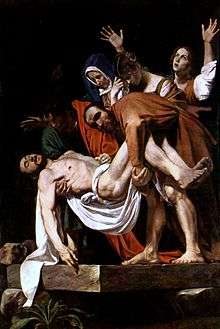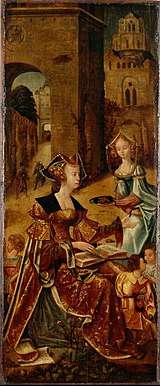Mary of Clopas
Mary of Clopas (Ancient Greek: Μαρία ἡ τοῦ Κλωπᾶ, María hē tou Clōpá), was one of the women present at the crucifixion of Jesus and bringing supplies for his funeral. The expression Mary of Clopas in the Greek text is ambiguous as to whether Mary was the daughter or wife of Clopas, but exegesis has commonly favoured the reading "wife of Clopas". Hegesippus identified Clopas as a brother of Saint Joseph.[1] In the Roman Martyrology she is remembered with Saint Salome on April 24.[2]
Saint Mary of Clopas | |
|---|---|
.jpg) Mary of Clopas - Sant'Andrea della Zirada Venice | |
| Myrrhbearer | |
| Venerated in | Eastern Orthodox Church Roman Catholic Church |
| Feast | May 23 (Orthodoxy) April 24 (Catholicism) |

Appearances in the gospels
Mary of Clopas is explicitly mentioned only in John 19:25, where she is among the women present at the crucifixion of Jesus:
Now there stood by the cross of Jesus His mother, and His mother’s sister, Mary of Clopas, and Mary Magdalene.
The Gospels of Mark and Matthew each include similar passages that are nearly identical to one another:
Among which was Mary Magdalene, and Mary the mother of James and Joseph, and the mother of Zebedee's children. (Matthew 27:56)
There were also women looking on afar off: among whom was Mary Magdalene, and Mary the mother of James the less and of Joses, and Salome. (Mark 15:40)
This has led some scholars to identify Mary of Clopas with "Mary the mother of James and Joseph/Joses".[3] The Gospels of Matthew (13:55–56) and Mark (6:3) mention James and Joseph/Joses (with Mark always using the less common variation "Joses") among the four brothers of Jesus.
According to some interpretations, the same Mary was also among the women that on resurrection morning went to the tomb to anoint the body of Jesus with spices. Matthew 28:1 calls her "the other Mary" to distinguish her from Mary Magdalene, while Mark 16:1 uses the name "Mary, the mother of James" (Maria Iacobi in Latin).
Apocryphal writings
In a manner very similar to the Gospel of John, the apocryphal Gospel of Philip (3rd century) also seems to list Mary of Clopas among Jesus' female entourage:
There were three who always walked with the Lord: Mary, his mother, and her sister, and Magdalene, the one who was called his companion. His sister and his mother and his companion were each a Mary.[4]
Adding to the confusion, the Gospel of Philip seems to refer to her as Jesus' mother's sister ("her sister") and Jesus' own sister ("his sister").
The Gospel of Pseudo-Matthew (7th century) presents Mary of Cleophas as the daughter of Cleophas and Anna:
Jesus met them, with Mary His mother, along with her sister Mary of Cleophas, whom the Lord God had given to her father Cleophas and her mother Anna, because they had offered Mary the mother of Jesus to the Lord. And she was called by the same name, Mary, for the consolation of her parents.[5]

Identity of Clopas
The expression Mary of Clopas in the Greek text is ambiguous as to whether Mary was the daughter or wife of Clopas, but exegesis has commonly favoured the reading "wife of Clopas". Clopas appears in early Christian writings as a brother of Joseph, and as the father of Simeon, the second bishop of Jerusalem. Eusebius of Caesarea, referencing the works of Hegesippus, relates in his Church History (Book III, ch. 11), that after the destruction of Jerusalem in 70 AD, the Christians of Jerusalem:
all with one consent pronounced Symeon, the son of Clopas, of whom the Gospel also makes mention; to be worthy of the episcopal throne of that parish. He was a cousin, as they say, of the Saviour. For Hegesippus records that Clopas was a brother of Joseph.[1]
This identification would make Mary of Clopas a sister-in-law of Mary, the mother of Jesus, possibly explaining the wording "His mother’s sister, Mary of Clopas" in John 19:25.
Clopas was sometimes further identified with Cleopas[6][7][8] and Alphaeus, father of James, one of the Twelve Apostles. In 1982, Stephen S. Smalley, Dean Emeritus of Chester Cathedral, deemed this identification "probable"[3] In medieval tradition, Clopas was identified as this Mary's father and the second husband of Saint Anne and the father of "Mary of Clopas",[2] allowing Mary to be identified as the half-sister of Mary, the mother of Jesus.
Mary of Clopas and the brothers of Jesus
Jerome (347-420), writing Against Helvidius in defense of perpetual virginity of the mother of Jesus, argued that the brothers of Jesus (James, Simon, Jude, and Joses or Joseph) were children of Mary of Clopas, the sister of the mother of Jesus, making them first cousins of Jesus. Jerome also identified James, the brother of Jesus, with the Apostle James, son of Alphaeus and thus supposed that Mary of Clopas was married to Alphaeus.[9]
This view finds support in a fragment found in a medieval manuscript, which lists four Maries mentioned in the gospels and bears the inscription "Papia" on the margin.[10][11][12] The attribution of this fragment to Papias of Hierapolis (ca. 70-163 AD) however has been disputed in favour of a medieval author (possibly Papias the lexicographer, fl. 1040s–1060s) by Anglican bishops and theologians J.B. Lightfoot (1828-1889)[13][14] and Brooke Foss Westcott (1825–1901).[12]
James Tabor deduced that "Mary the mother of James and Joses" is none other than Mary, the mother of Jesus herself.[15] This interpretation would necessitate that Mary the mother of Jesus married a man named Clopas, after her marriage to Joseph (perhaps after his death). Tabor proposes that a brother of Joseph would have been obliged to wed his widowed wife in a Levirate marriage, despite this only being permissible if the first marriage had been childless.[15]
References
| Wikisource has the text of the 1913 Catholic Encyclopedia article Mary of Cleophas. |
| Wikimedia Commons has media related to Mary of Clopas. |
- Eusebius of Caesarea, Church History, Book III, ch. 11.
- Herbermann, Charles, ed. (1913). . Catholic Encyclopedia. New York: Robert Appleton Company.
- S. S. Smalley. "Mary," New Bible Dictionary, 1982 p. 793.
- The Old and New Testament and Gnostic contexts and the text are discussed by Robert M. Grant, "The Mystery of Marriage in the Gospel of Philip" Vigiliae Christianae 15.3 (September 1961:129-140).
- The Gospel of Pseudo-Matthew. Retrieved 19 June 2018.
- St. Cleophas, Catholic Online
- Apostle Cleopas, OrthodoxWiki
- Joseph the Betrothed, OrthodoxWiki
- "CHURCH FATHERS: The Perpetual Virginity of Mary (Jerome)". www.newadvent.org.
- Papias of Hierapolis. Exposition of the Sayings of the Lord. Fragment X. Peter Kirby. Retrieved 10 September 2015.
- "Fragments of Papias. Fragment X." biblehub.com. Retrieved 2019-05-04.
(1.) Mary the mother of the Lord; (2.) Mary the wife of Cleophas or Alphæus, who was the mother of James the bishop and apostle, and of Simon and Thaddeus, and of one Joseph; (3.) Mary Salome, wife of Zebedee, mother of John the evangelist and James; (4.) Mary Magdalene. These four are found in the Gospel. James and Judas and Joseph were sons of an aunt (2) of the Lord's. James also and John were sons of another aunt (3) of the Lord's. Mary (2), mother of James the Less and Joseph, wife of Alphæus was the sister of Mary the mother of the Lord, whom John names of Cleophas, either from her father or from the family of the clan, or for some other reason. Mary Salome (3) is called Salome either from her husband or her village. Some affirm that she is the same as Mary of Cleophas, because she had two husbands.
- "Fragments of Papias. Fragment X." biblehub.com. Retrieved 2019-05-04.
This fragment was found by Grabe in a ms. of the Bodleian Library, with the inscription on the margin, "Papia." Westcott states that it forms part of a dictionary written by "a mediæval Papias. [He seems to have added the words, "Maria is called Illuminatrix, or Star of the Sea," etc, a middle-age device.] The dictionary exists in ms. both at Oxford and Cambridge."
- Lightfoot, J.B. (1865). "The Brethren of the Lord". philologos.org. Archived from the original on 2018-06-18. Retrieved 2016-05-31.
The testimony of Papias is frequently quoted at the head of the patristic authorities, as favouring the view of Jerome. [...]. It is strange that able and intelligent critics should not have seen through a fabrication which is so manifestly spurious. [...] [T]he passage was written by a mediaeval namesake of the Bishop of Hierapolis, Papias [...] who lived in the 11th century.
- "Archived copy". Archived from the original on 2015-11-16. Retrieved 2015-10-06.CS1 maint: archived copy as title (link)
- Tabor, James D. (2006). The Jesus Dynasty: A New Historical Investigation of Jesus, His Royal Family, and the Birth of Christianity. Simon & Schuster. ISBN 0-7432-8723-1.